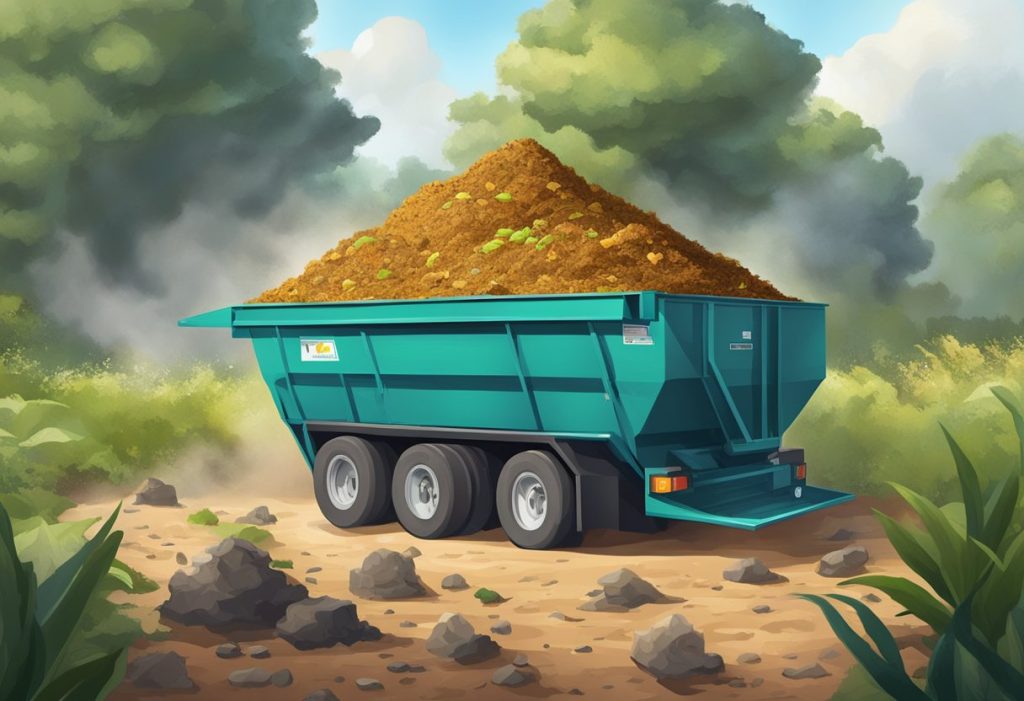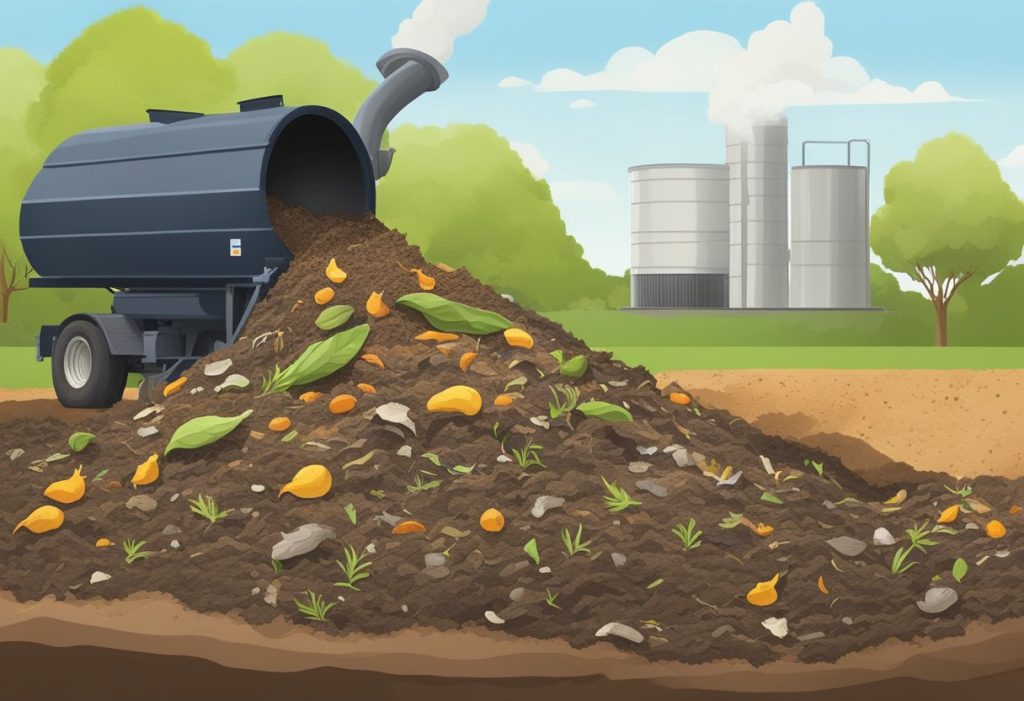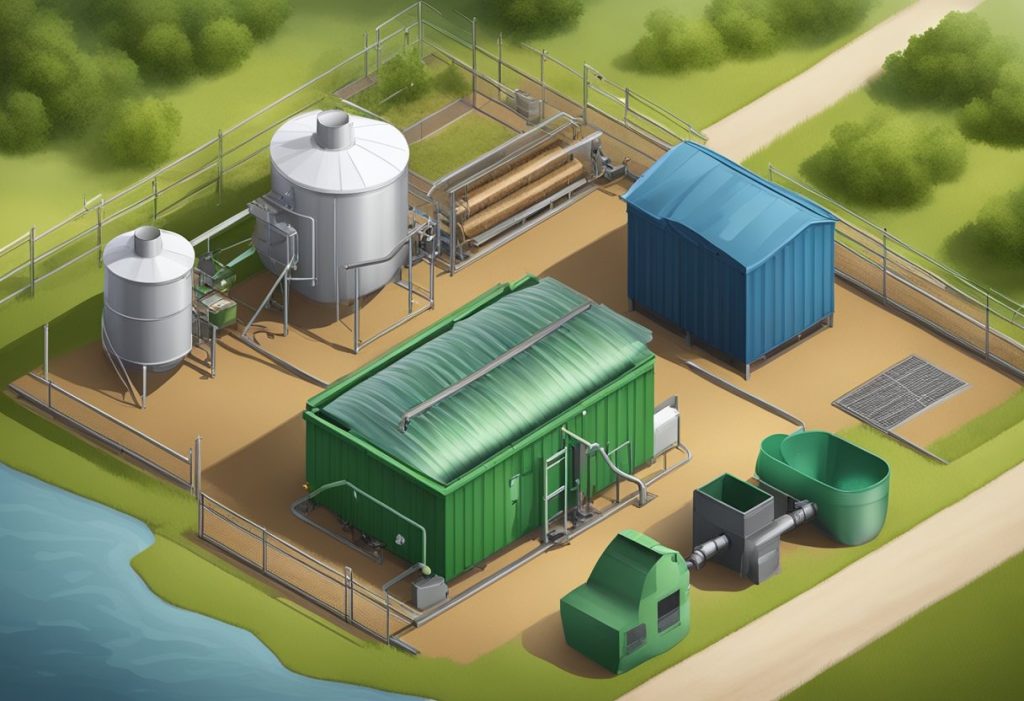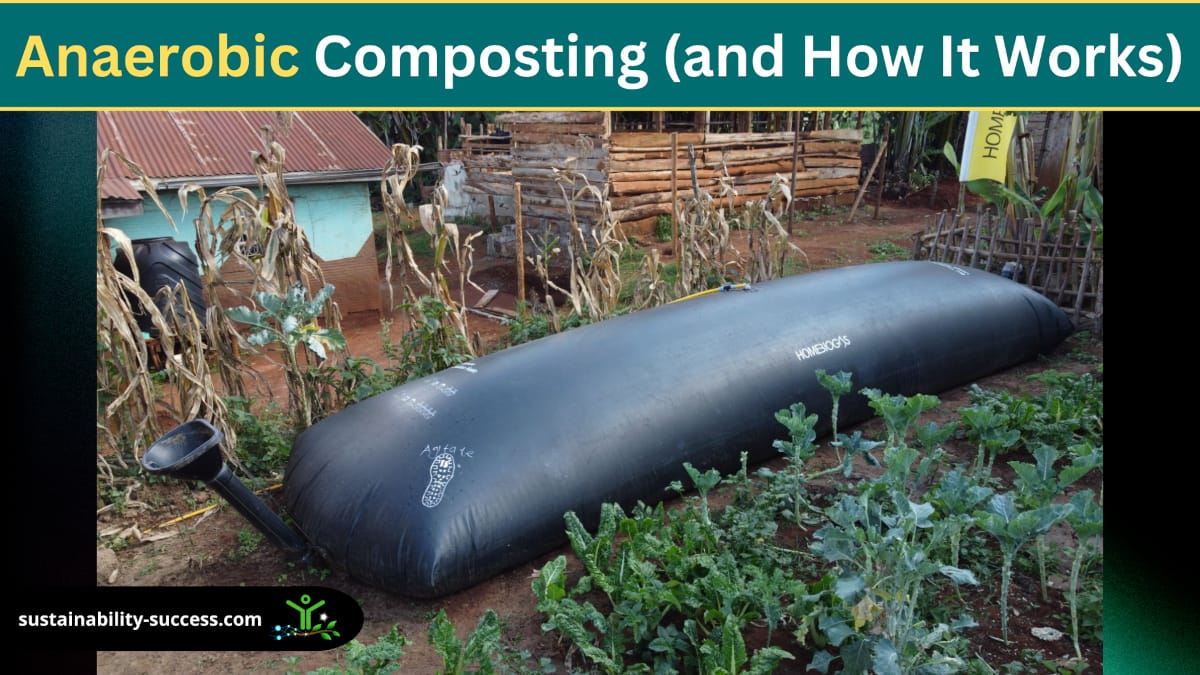Anaerobic composting refers to the decomposition of organic material in an environment devoid of oxygen. In this method, microorganisms that thrive in oxygen-free environments work to decompose materials such as kitchen scraps, plant residue, and animal manure.
While aerobic composting requires active aeration, anaerobic composting occurs in a sealed environment where oxygen is limited or absent. This creates different by-products and has distinct implications for the compost produced.
Under anaerobic conditions, the process moves at a slower pace, and due to the lack of oxygen, it typically generates methane, a potent greenhouse gas, and a more pungent odor compared to aerobic methods.

Because anaerobic composting does not require turning or aeration, it can be considered less labor-intensive than its aerobic counterpart. This method is often conducted in closed systems like digesters or even simple, sealed containers.
The diversity of anaerobic organisms breaks down the composting material in a distinct manner that, over time, results in a nutrient-rich end product. Although the compost is usually more acidic and takes longer to stabilize, it can still be applied to gardens and soil with careful management to provide the benefits of organic fertilizer.
Understanding the balance of conditions necessary for successful anaerobic composting is crucial. Ensuring that the right mix of waste materials is used, that the system is properly sealed, and that any potential issues are promptly addressed can lead to effective compost production with the added advantage of minimizing labor and maintenance.
Key Takeaways
- Anaerobic composting decomposes waste without oxygen, relying on specialized microorganisms.
- It is a slower process that results in methane production and acidic compost, but requires less labor.
- Proper management of conditions and materials is vital for successful anaerobic composting.
Basics of Composting
As we explore composting, it’s fundamental to understand the two primary methods, aerobic and anaerobic, and how they manage organic matter. Our focus will be on anaerobic composting, differentiating it from its aerobic counterpart and discussing its core principles and the nature of organic matter processed by this method.
Aerobic vs Anaerobic Composting
Aerobic composting requires oxygen to facilitate the decomposition process. In this method, microorganisms consume organic material and oxygen, converting waste into compost with the help of regular turning to maintain oxygen levels.
In contrast, anaerobic composting does not use oxygen and works with microorganisms that thrive in oxygen-free environments. This type of composting often occurs in a sealed container, where organic matter breaks down slower than in aerobic processes, typically producing a stronger odor due to the byproducts like methane.
| Composting Type | Oxygen Requirement | Microbial Environment | Byproducts |
|---|---|---|---|
| Aerobic | Required | Aerobic microorganisms | Carbon dioxide |
| Anaerobic | Not required | Anaerobic microorganisms | Methane, alcohols |
Principles of Anaerobic Digestion
Our approach to anaerobic digestion involves a sealed environment where organic material degrades without air. We need to ensure that this process occurs in a moisture-controlled space to prevent putrefaction and maximize efficiency.
Key principles include:
- Airtight Containment: To maintain anaerobic conditions, the composting vessel must be completely sealed off from air.
- Moisture Control: Too much moisture can cause leachate issues and too little can slow down the composting process, so balance is crucial.
Understanding Organic Matter
For anaerobic composting, the organic matter we refer to includes food waste and similar biodegradable materials. These decompose regardless of oxygen presence, but the method chosen affects the decomposition rate and the compost’s final quality.
- Biodegradable Material: Food waste, garden trimmings, and other organic waste are suitable for anaerobic digestion.
- Decomposition Time: Anaerobic processes take longer than aerobic due to the slower activity of anaerobic microorganisms.
In anaerobic composting, it is important to prioritize a balance of nitrogen-rich green waste, such as vegetable scraps, with carbon-rich brown waste, such as dried leaves, to support an effective composting process.
Setting Up an Anaerobic Composting System
In anaerobic composting, we utilize specific conditions to decompose organic matter without oxygen. The key to success lies in choosing an appropriate container and creating the right environmental conditions to facilitate the process.
Choosing a Container
To set up an anaerobic composting system, we need a suitable container that will exclude oxygen and support adequate moisture for the composting process. Here are characteristics to look for:
- Type: A bin with a tight-fitting lid is essential. This could be a specialized compost bin or an ordinary trash bin. Even a sturdy garbage bag can serve the purpose.
- Size: Select a size based on the amount of organic waste we plan to compost. Bigger isn’t always better; consider space and manageability.
- Material: Non-biodegradable materials like plastic or metal will contain the organic matter without absorbing moisture.
- Ventilation: Some containers come with built-in drainage or ventilation holes at the bottom to let excess moisture escape. If we’re using a garbage bag, make small holes for drainage.
Creating the Right Conditions
Ensuring the right environment inside the container is crucial for anaerobic composting to take place:
- Microorganisms: Anaerobic bacteria and microbes are the primary agents in this process, breaking down the waste. We don’t need to add them; they naturally occur in the waste materials.
- Balance of Materials: A mix of carbon-rich (browns like leaves, paper) and nitrogen-rich materials (greens like food scraps) leads to more effective composting.
- Moisture Level: Adequate moisture is important to encourage microbial activity, but excess water should be avoidable as it can lead to a putrid odor and not suit the process. We aim for the consistency of a well-wrung sponge.
- Temperature: Keep the container in a location where temperature remains relatively constant, as extreme cold or heat can hinder microbial activity.
- pH Level: While we don’t need to frequently test pH levels in anaerobic composting, be aware that a neutral to slightly acidic environment is generally more conducive for the bacteria and microbes.
By attentively selecting the right container and diligently creating the appropriate conditions, we establish a thriving environment for anaerobic composting. Remember: patience is a virtue in this process, as decomposition without oxygen takes time.
Materials and Waste Management
In managing organic waste through anaerobic composting, we prioritize the selection of appropriate materials and implement strategies to manage odors and pathogens effectively.
Appropriate Organic Inputs
When considering materials for anaerobic composting, we focus on a diverse mix of organic waste. Here’s what we can include:
- Food scraps: Vegetable peels, fruit waste, and coffee grounds are excellent inputs.
- Yard waste: Leaves, grass clippings, and straw add necessary bulk.
- Manure: This is a nitrogen-rich addition that accelerates the composting process.
- Kitchen waste: All non-meat kitchen scraps are suitable.
- Tougher materials: Small twigs and similar yard debris can be included but may take longer to break down.
We ensure that these materials are moistened and an optimal balance between green (nitrogen-rich) and brown (carbon-rich) components is achieved to promote effective breakdown.
Dealing with Odors and Pathogens
Anaerobic composting, while efficient, can produce an unpleasant odor and potentially harbor pathogens. Here’s how we manage these issues:
Odor Control:
- Seal properly: Enclose the compost in airtight containers or pits lined and covered with impermeable material.
- Balance inputs: Maintain the correct moisture and material balance to minimize odors.
Pathogen Reduction:
- Temperature monitoring: Ensure the pile reaches sufficient temperatures to kill off harmful bacteria.
- Time: Allow the compost to sit for an extended period post-decomposition to ensure any residual pathogens are neutralized.
Through careful selection of inputs and diligent management of the composting environment, we maintain a clean and efficient anaerobic composting process.
Composting Process and Maintenance
In anaerobic composting, we manage organic waste by creating conditions that enable decomposition without oxygen. Our goal is to ensure a successful transformation of waste into compost through careful monitoring and maintenance.
The Anaerobic Process
The cornerstone of anaerobic composting is the absence of oxygen. We seal organic waste in containers or bags, preventing air access. This environment allows anaerobic microorganisms to thrive, breaking down the material through a process called digestion.
The primary role during this phase is setting up the composting space correctly, ensuring that it is sufficiently oxygen-depleted for the anaerobes.
Fermentation and Decomposition
During decomposition, fermentation plays a crucial role. We facilitate this by adding inoculants like Bokashi bran into our waste mixture to kickstart the fermentation process.
The material should be kept in an acidic environment to suppress pathogens and foul odors. An essential part of fermentation is monitoring the temperature and ensuring the material remains moist for optimal microorganism activity.
Ongoing Maintenance and Troubleshooting
- Observation: Regularly check for signs of proper decomposition like a sour, vinegar-like smell as opposed to putrid odors.
- Leachate collection: We use a tray or container beneath the compost to collect any liquid runoff, which can be diluted and used as liquid fertilizer.
- Temperature checks: Ensuring the pile does not become too hot is crucial as extreme temperatures can kill anaerobic bacteria.
- Addressing issues: If we encounter a foul smell or pest invasion, we adjust the moisture level, add more browns (carbon-rich material), or correct the pH, enhancing the environment for the desired decomposition process.
Through these steps, we can maintain and troubleshoot our anaerobic compost setup to achieve a successful transformation of waste into valuable compost for our soil.
Benefits and Drawbacks
As we explore anaerobic composting, it’s crucial to weigh its advantages and potential disadvantages before integrating it into our gardening practices.
Advantages of Anaerobic Composting
- Nutrient-Rich: Anaerobic composting creates a nutrient-rich soil amendment, which can be beneficial for plant growth.
- Less Work: It requires less physical effort from us as it does not necessitate regular turning or aeration.
Potential Disadvantages
- Greenhouse Gas Emissions: This process can release methane and carbon dioxide, potent greenhouse gases.
- Odor and Leachate: A possible byproduct is leachate, a liquid that, if improperly managed, can be harmful. Additionally, anaerobic composting can produce a strong odor due to the organic matter breaking down in the absence of oxygen.
Utilizing Compost Products

As we consider the practical uses of anaerobic composting, we recognize the direct benefits in soil enhancement and biogas production. Our finished compost, rich in nutrients, serves not only as a vital soil amendment but also as a source for energy.
Soil Enhancement
Our anaerobic composting efforts culminate in a soil amendment product that greatly benefits the earth. This finished compost is instrumental in improving soil structure, increasing moisture retention, and providing essential nutrients to plants.
To effectively utilize the compost in our garden, we incorporate it into the soil at least a few months after the composting process has ended, as fresh anaerobic compost can be too acidic for direct application to plants.
- Optimal Nutrient Release: Incorporating finished compost into garden beds ensures a steady release of nutrients as plants grow.
- Improved Soil Structure: The addition of compost enhances soil aeration and water retention, fostering a robust garden ecosystem.
Biogas Production
Anaerobic composting also presents the opportunity for biogas production—an energy source containing methane. During the composting process, bacteria break down organic matter in an oxygen-free environment, producing biogas as a byproduct.
We capture and harness this biogas, a renewable energy that can be used for cooking, heating, or even generating electricity.
- Renewable Energy Source: Biogas production is a sustainable alternative to fossil fuels with the potential for multiple applications.
- Reduction in Emissions: Utilizing biogas reduces our reliance on conventional energy sources, thus decreasing overall greenhouse gas emissions.
Through these practices, we efficiently transfer the value from waste into tangible benefits, supporting a more sustainable interaction with our environment.
Advanced Topics in Anaerobic Composting
In our advanced exploration of anaerobic composting, we focus on the innovative Bokashi composting technique and the intricacies of large-scale waste management systems that utilize anaerobic processes.
Bokashi Composting Technique
Bokashi composting is a specific method we use to ferment organic waste, including food scraps, using a specialized inoculant. This inoculant typically contains a mixture of microorganisms that promote anaerobic fermentation. The core aspects of bokashi are:
- Feedstock: We typically add small-sized waste for uniform fermentation.
- Inoculant: A blend of Effective Microorganisms (EM) speeds up the composting process and reduces odors.
- Effort: Bokashi composting requires layering the waste with the inoculant in sealed containers and periodically draining off leachate.
For bokashi to be efficient, the key is maintaining an anaerobic environment and proper moisture levels.
Large-Scale Waste Management
When we address large-scale waste management, anaerobic digesters become pivotal in processing vast amounts of organic waste. Such systems are designed to handle large volumes of feedstock, transforming them into valuable end-products like biogas and biofertilizers.
- Digester Design: Adjusting the design of the digester to accommodate the scale and type of organic waste is critical.
- Control Systems: We implement sophisticated control systems to monitor and adjust conditions within the digester for optimal performance.
Our focus on large-scale systems is to effectively reduce greenhouse gas emissions and produce renewable energy, thus contributing to a sustainable circular economy.
Environmental Impact and Sustainability

In addressing the environmental impact and sustainability of anaerobic composting, we need to consider its role in the reduction of greenhouse gases and the establishment of sustainable waste practices.
Reduction of Greenhouse Gases
Anaerobic digestion (AD) as a waste management strategy significantly reduces the emissions of greenhouse gases such as methane and carbon dioxide.
- Methane: Traditionally, landfills are major sources of human-related methane emissions. AD helps mitigate this by diverting organic waste from landfills, thereby reducing methane produced during decomposition.
- Carbon Dioxide: Through AD, the organic waste is converted into biogas, a renewable energy source that displaces the use of fossil fuels. This results in a net reduction of carbon dioxide emissions.
Sustainable Waste Practices
Anaerobic composting aligns with sustainable waste practices by transforming organic waste into valuable resources.
- Resource Recovery: We harvest biogas and nutrient-rich digestate from the AD process, which can be further used for energy production and as a soil amendment respectively.
- Circular Economy: Integrating AD into waste management promotes a circular economy approach, where waste is not merely discarded but is repurposed to minimize environmental impacts.
Design Considerations for Anaerobic Systems

We must meticulously plan our anaerobic systems to optimize functionality and efficiency, focusing on the specific design of the digester and the essential features of the compost bin.
Anaerobic Digester Design
In tailoring our anaerobic digester, size and type are decisive factors. We carefully assess the organic loading rate (OLR) and the hydraulic retention time (HRT) to determine the appropriate digester volume.
- Types: We distinguish between different digester types such as continuous, batch, and semi-continuous systems, each with unique design criteria.
- Container: The digester must be enclosed, often in a sturdy tank or vessel, made from materials like concrete or steel to withstand the byproducts of anaerobic digestion.
- Insulation: Proper insulation is crucial to maintain the mesophilic or thermophilic temperatures required for microbial activity.
- Aeration Control: While not involving aeration in the traditional sense, we ensure an anaerobic environment by sealing the digester from oxygen ingress.
Compost Bin Features
Our compost bin design caters to the anaerobic decomposition of organic waste. We ensure the bin has an impermeable barrier like a plastic or garbage bag to restrict the flow of oxygen, necessary for anaerobic composting.
- Materials: Bins can be constructed from wood chips, sawdust, or recycled plastic, tailored to the size required for the intended use.
- Sealing: Bins come with lids or covers that help create an anaerobic condition by preventing air flow. We ensure these seals are sufficient to contain the process without allowing excess moisture or pests.
- Venting: Although aeration is not desired, we still design for controlled venting to allow for the safe release of built-up gases from the natural decomposition process.
Our design considerations are fundamental to the efficient operation of anaerobic systems, addressing the specific needs of both the digester and the compost bin.
We understand the importance of controlled environmental conditions and physical components to facilitate effective waste processing and energy recovery.
FAQ
In this section, we address some of the most common queries about anaerobic composting, clarifying the process, methods, and considerations for those looking to utilize this technique.
What are the common methods used in anaerobic composting?
The common methods of anaerobic composting include piling up organic matter, adding moisture, and covering it with a tarp to limit oxygen exposure. Some people also use sealed bins with drainage holes or even use heavy-duty garbage bags to create an anaerobic environment.
How can anaerobic composting be done at home?
To start anaerobic composting at home, you can collect your organic waste in a container with a tight-fitting lid and drain holes. A simple approach is layering food scraps and garden waste in a plastic bin, covering it securely, and letting the material decompose over time.
What is the difference between aerobic and anaerobic composting?
The key distinction between aerobic and anaerobic composting is the presence of oxygen. Aerobic composting requires a constant supply of oxygen and typically involves turning the compost to aerate it, while anaerobic composting happens without oxygen, relying on microorganisms that thrive in sealed, oxygen-deprived conditions.
How long does the process of anaerobic composting typically take?
Anaerobic composting generally takes longer than aerobic methods, often several months to a year or more, depending on factors like the types of materials being composted and the conditions maintained throughout the process.
Can the presence of anaerobic bacteria in compost be harmful?
The presence of anaerobic bacteria in compost is typically not harmful to plants because these bacteria are a natural part of the decomposition process. However, it is important to ensure that the final compost is well-cured before use to prevent any potential phytotoxicity or plant diseases.
Related Articles:


